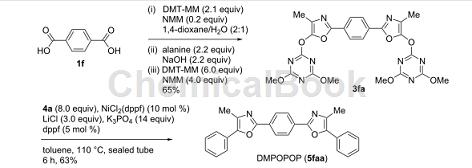Background and overview[1]
1,4-bis[2-(4-methyl-5-phenyloxazole)]benzene can be used as a pharmaceutical synthesis intermediate. If 1,4-bis[2-(4-methyl-5-phenyloxazole)]benzene is inhaled, move the patient to fresh air; if skin contact occurs, remove contaminated clothing and wash with soap and water. Rinse skin thoroughly with water and seek medical attention if you feel discomfort. If eye contact occurs, separate eyelids, rinse with running water or saline, and seek medical attention immediately. If ingested, rinse mouth immediately. Do not induce vomiting and seek medical attention immediately.

Preparation[1]
The preparation of 1,4-bis[2-(4-methyl-5-phenyloxazole)]benzene is as follows:

Condition A: Add 5-(triazinyloxy)oxazole 3aa (100mg, 0.318mmol), phenylboronic acid (4a, 155mg, 1.27mmol), NiCl2 to a round-bottomed flask equipped with a reflux condenser. (dppf) (10.9 mg, 0.318 mmol), K3PO4 (473 mg, 2.23 mmol), LiCl (40.4 mg, 0.954 mmol) and toluene (2.3 mL). After stirring the reaction mixture at 110°C for 3 hours, the reaction mixture was cooled to room temperature. The reaction mixture was diluted in CH2Cl2 (10 mL), filtered through a short pad of Celite, and the filtrate was concentrated under reduced pressure. The residue was purified by flash evaporation and column chromatography (CH2Cl2:hexane=70:30) to obtain 5aaa (68%) as a white solid.
Condition B: Add 5-(triazinyloxy)oxazole 3aa (100mg, 0.318mmol), 4-ethoxycarbonylphenylboronic acid (4b, 246mg, 1.27mmol) to a screw cap tube in N2 , NiCl2 (dppf) (10.9mg, 0.0159mmol), K3PO4 (473mg, 2.23), LiCl (40.4mg, 0.954mmol), DPPF (8.8mg, 0.0159mmol) and toluene (2.3mL). The mixture was stirred at 110°C for 6 hours and the reaction mixture was cooled to room temperature. The reaction mixture was diluted, CH2Cl2 (10 mL) was filtered through a short pad of Celite, and the filtrate was concentrated under reduced pressure. The residue was purified by flash column chromatography (EtOAc:hexane = 10:90) to obtain 1,4-bis[2-(4-methyl-5-phenyloxazole)]benzene 5aab (62.5 mg, 64 %), as a white solid.
Main reference materials
[1] Development of a method for the synthesis of 2,4,5-trisubstitutedoxazoles composed of carboxylic acid, amino acid, and boronic acid

 微信扫一扫打赏
微信扫一扫打赏

